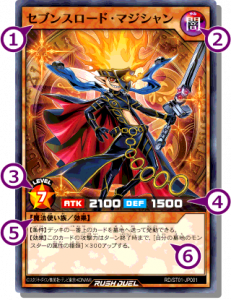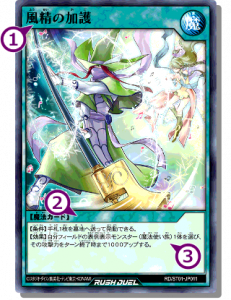All the rules so far (and more) compiled in one convenient website.
CARD TYPES
Rush Duels use 3 types of cards: Monsters, Spells, and Traps.
MONSTER CARDS
These are the monsters that’ll fight for you as your swords and shields. There are “Normal Monsters” which have no effects, and “Effect Monsters” which have special effects!
1. Card Name
2. Attributes: You have DARK, LIGHT, EARTH, WATER, FIRE, and WIND (![]() ) for a total of 6 different attributes.
) for a total of 6 different attributes.
3. Level: The higher the level, the stronger the monster.
4. ATK/DEF: ATK is your Attack Power, and DEF is your Defense Power.
5. Type: There’s a number of various types!
6. Monster Information: Effect Monsters have special requirements or effects that are used in Duels.
These are cards that can be played straight from the hand to turn the duel in your favor.
1. Card Name
2. Icon: Normal Spells have no Icons, but Field Spells have the (Field) Icon.
3. Effect: The abilities that are used when you play this Spell Card are written here.
These are special cards that can also be activated on your opponent’s turn. They have lots of effects that disrupt your opponent, and they are used by first placing them face-down on the Field.
1. Card Name
2. Effects: The abilities that are used when you play this Trap Card are written here.
DUEL FIELD
Cards are played by placing them in the Duel Field and then Dueling!
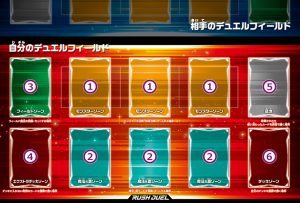
1. Monster Zones: This is where you Normal Summon, Special Summon, or Set monsters.
2. Spell & Trap Zones: This is where you Activate or Set Spells and Trap Cards.
3. Field Zone: This is where you Activate or Set Field Spells.
4. Extra Deck Zone: This is where special cards that don’t go into your deck are placed face-down.
5. Graveyard: This is where cards that are destroyed or are done being used are placed face-up.
6. Deck Zone: This is where you place your Deck face-down.
THE FLOW OF THE DUEL
Start the fight by shuffling your Deck(A pile from 40 up to 60 cards [1]) and place it face-down in your Deck Zone! Both players start by drawing 4 cards from the top of their decks!
The flow of your turn goes in the following order!

(1) DRAW PHASE (Increase your hand) -> (2) MAIN PHASE (Call forth Monsters!!) -> (3) BATTLE PHASE (Attack with Monsters!!) -> (4) END PHASE (On to your opponent’s turn)
Both players take turns back and forth, and whoever brings their opponent’s Life Points (8000) to 0 wins!
※Keep in mind that the player going first doesn’t get a Battle Phase on their first turn!
1. DRAW PHASE
The first thing to happen during your turn is your Draw Phase. A “Draw” is what you call adding cards from your deck to your hand. In a Rush Duel, each turn you draw cards until you have 5 cards in your hand. Also, if you have 5 or more cards in your hand, you draw 1 card. There’s no limit to the number of cards in your hand.
2. MAIN PHASE
Prepare for combat during the Main Phase.
–Normal Summoning/Setting Monsters
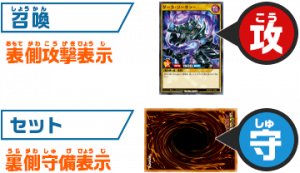
During your Main Phase, you can Normal Summon or Set monsters from your hand to your “Monster Zones”. There are two types of basic summoning, where you can choose to either Normal Summon a monster in Face-Up Attack Position (Vertically Face-Up), or Set a monster in Face-Down Defense Position (Horizentally Face-Down). In Rush Duels, you can Normal Summon or Set as many Monsters as you want from your hand in a single turn.
–Tribute Summoning
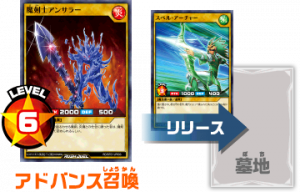
If you Normal Summon or Set Level 5 or higher Monsters, it’s called a “Tribute Summon”. In order to Tribute Summon, you have to Tribute(Send to the Grave) Monsters.
Tribute 1 Monster for Level 5 or 6, and 2 Monsters for Level 7 or higher.
–Changing Battle Positions
A monster that has been on the field since the last turn can change its Battle Position once per turn. If it was in Attack Position it becomes Defense Position, and if it was in Defense Position it becomes Attack Position. Also, if a monster that was face-down becomes face-up, that is called “flipping face-up”.
–Monster [Effects]
There are many different effects that can be activated by fulfilling the [Requirements] written on the cards.
–How to play Normal Spells
Activate these by placing them from your hand to your “Spell & Trap Zones” face-up, or you can first set them face-down and use them later by putting them face-up. A Normal Spell that you’ve finished using is sent to the Graveyard. You can activate as many Normal Spell Cards as you want per turn.
–How to play Field Spell Cards
You can Activate these from your hand by placing them face-up in your Field Zone, or you can also Set them. As long as a Field Spell is face-up, its [Effect] is continuously applied. You can Activate/Set a new Field Spell by sending the previous one to the Graveyard. You can play as many Field Spells as you want per turn.
–How to play Trap Cards (1)
These cards are Set face-down in your Spell & Trap Zones and can be used starting from your opponent’s next turn after you have Set them . There are even cards that can be activated during your opponent’s Battle Phase, and not just the Main Phase, depending on the activation timing written in them. Trap Cards that have been used are sent to the Graveyard. You can activate as many Trap Cards as you want per turn.
–How to Play Trap Cards (2)
If there are 2 or more Trap Cards with the same activation timing, only 1 can be activated. The non-turn Player (the player who is not playing this turn) has a chance to activate a Trap Card first. If they don’t, the turn Player can choose to activate a Trap Card. [2]
3. BATTLE PHASE
The Battle Phase is where you attack the opponent with your Monster Cards. Each of your Attack Position Monsters can attack once during each Battle Phase. (But the player going first doesn’t get a Battle Phase on their first turn.)
Declare an attack by choosing one Monster to attack with from your side of the field, and one Monster to be the Attack Target from your opponent’s side of the field.
–Direct Attacks
If your opponent has no monsters, you can attack a player directly (a “Direct Attack”).
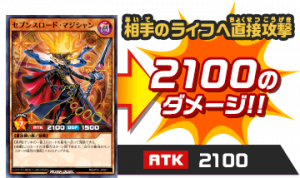
(Inflict Damage to your opponent equal to the value of your monster’s ATK)
–Attacking an Attack Position Monster
Compare the ATK of your monster and your opponent’s monster.
If your monster’s ATK is higher than your opponent’s:
Destroy your opponent’s monster, and inflict damage to your opponent equal to the difference in ATK.
If your monster’s ATK is equal to your opponent’s:
Destroy both players’ monsters, and neither player takes damage.
If you monster’s ATK is lower than your opponent’s:
Destroy your monster, and you take damage equal to the difference.
-Attacking Defense Position Monsters
Compare your monster’s ATK and your opponent’s monster’s DEF
※If your opponent’s monster is in face-down Defense Position, switch it to face-up Defense Position(Flipping it face-up) and then calculate its DEF.
If your monster’s ATK is higher than your opponent’s monster’s DEF:
Destroy the opponent’s monster, but you can’t inflict damage to your opponent.
If your monster’s ATK is equal to your opponent’s monster’s DEF:
Neither monster is destroyed, and neither player takes damage.
If your monster’s ATK is lower than your opponent’s monster’s DEF:
Neither monster is destroyed, but you take damage equal to the difference.
Example battle:

–Attack Position vs Attack Position
Compare both monsters’ ATK, and if yours is higher, destroy your opponent’s!
Also, inflict damage to your opponent equal to the difference! If both monsters have the same ATK, both are destroyed and no damage occurs!
But if both players’ monsters have 0 ATK, then neither monster is destroyed and no damage occurs!
–Attack Position vs Defense Position
Compare the Attack Position monster’s ATK and the Defense Position monster’s DEF!
If your ATK is higher, destroy your opponent’s monster, but your opponent doesn’t take damage.
If their DEF is higher, take damage equal to the difference! If the ATK and DEF are the same, no damage occurs and neither monster is destroyed!
4. END PHASE
The End Phase is the end of your turn. If there’s nothing left for you to do during your Main Phase and Battle Phase, declare the end of your turn, and make it clear that your turn is over.
Other Rules
-Number of copies of cards with the same name and “Legend” Cards
You can include up to 3 copies of cards with the same name in your Deck. However, your Deck can only contain 1 card in total with the “LEGEND” ![]() icon.
icon.
-Number of uses of Monster [Effects]
The [effects] of monsters on the field can be activated once per turn as long as they remain face-up on the field.
-Special Summoning monsters
Placing monsters on the field via card effects or other methods that are not a Normal Summon or Set is called a “Special Summon”.
-If the number of cards remaining in the Deck is not enough
If the number of cards remaining in the Deck is not enough, so that it is not possible for you to draw the required number of cards when you are required to, you lose the Duel. (Example: If you enter your Draw Phase while there are 4 or less cards in your Deck and you have 0 cards in your hand, etc.)
-If there are 3 monsters in the Monster Zones
If there are 3 monsters in your Monster Zones, you cannot Normal Summon or Set a Level 4 or lower monster from your hand.
-If there are 3 Spell or Trap Cards in the Spell & Trap Zone
If there are 3 Spell or Trap Cards in your Spell & Trap Zone, you cannot activate or set Normal Spell or Trap Cards from your hand.
-Timing for [Requirements] and [Effects]
The resolution of card [requirements] and [effects] are considered to be performed during a single timing. (If the contents of the activation requirements of a Trap Card are included in the [requirements] or [effects] of a card that was previously used, that Trap card can be activated without missing the timing)[3]
TL Notes:
[1]: At the time of the translation, this particular website says that the Deck consists of 60 cards (no variable number like “40 to 60”). However other resources explaining the rules for Rush Duel have mentioned before that Decks consists of 40 to 60 cards.
[2]: See next note.
[3]: Perhaps this is a little hard to understand if you don’t put it in context with the Official Card Game’s rules. In the OCG (and TCG), costs for effects are paid in advance to activate an effect, then players get the opportunity to respond to that activation, and only after you have built and resolved a chain of effects (if any), you finally get to resolve the first effect that was activated. We know from the [2] note that only one player can activate cards in a given timing, so you would activate effects one by one. And what the [3] note is saying is that if one of these cards that was activated contains some action, whether in its [requirement] or [effect], that fulfills the requirements for a new card, then that new card can be activated after this effect resolves.
Let’s use a hypothetical example:
Card #1
[Requirement]: Send 1 monster from your field to the Graveyard.
[Effect]: Inflict 500 damage to your opponent.
Card #2
[Requirement]: Activate when you receive damage.
[Effect]: Gain that much LP.
Card #3
[Requirement]: Activate when a monster is sent from the Field to the GY.
[Effect]: Special Summon that monster to the same side of the Field where it was before.
If I activate Card #1, I send a monster to the Graveyard and inflict damage. Since damage was inflicted, the timing is correct to activate Card #2. According to OCG rules, sending a monster to the Graveyard was not the last thing to happen, so it would be an incorrect timing to activate Card #3 after Card #1 resolves. However, in Rush Duels, both the [Requirement] and [Effect] of Card #1 are considered to resolve in a single timing, so it would be possible to activate Card #3.
This will likely become a lot clearer as we get more cards in Rush Duels with activation timings that fit right into this rule.

![[Rush Duel] “How to Play” website added](https://cdn.ygorganization.com/2020/04/battle-image.jpg)
